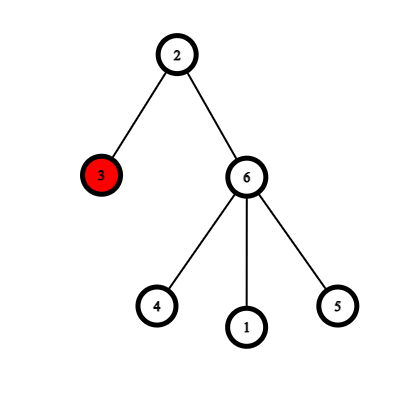CF1605D.Treelabeling
普及/提高-
通过率:0%
AC君温馨提醒
该题目为【codeforces】题库的题目,您提交的代码将被提交至codeforces进行远程评测,并由ACGO抓取测评结果后进行展示。由于远程测评的测评机由其他平台提供,我们无法保证该服务的稳定性,若提交后无反应,请等待一段时间后再进行重试。
题目描述
Eikooc and Sushi play a game.
The game is played on a tree having n nodes numbered 1 to n . Recall that a tree having n nodes is an undirected, connected graph with n−1 edges.
They take turns alternately moving a token on the tree. Eikooc makes the first move, placing the token on any node of her choice. Sushi makes the next move, followed by Eikooc, followed by Sushi, and so on. In each turn after the first, a player must move the token to a node u such that
- u is adjacent to the node v the token is currently on
- u has not been visited before
- u⊕v≤min(u,v)
Here x⊕y denotes the bitwise XOR operation on integers x and y .
Both the players play optimally. The player who is unable to make a move loses.
The following are examples which demonstrate the rules of the game.
 Suppose Eikooc starts the game by placing the token at node 4 . Sushi then moves the token to node 6 , which is unvisited and adjacent to 4 . It also holds that 6⊕4=2≤min(6,4) . In the next turn, Eikooc moves the token to node 5 , which is unvisited and adjacent to 6 . It holds that 5⊕6=3≤min(5,6) . Sushi has no more moves to play, so she loses.
Suppose Eikooc starts the game by placing the token at node 4 . Sushi then moves the token to node 6 , which is unvisited and adjacent to 4 . It also holds that 6⊕4=2≤min(6,4) . In the next turn, Eikooc moves the token to node 5 , which is unvisited and adjacent to 6 . It holds that 5⊕6=3≤min(5,6) . Sushi has no more moves to play, so she loses.  Suppose Eikooc starts the game by placing the token at node 3 . Sushi moves the token to node 2 , which is unvisited and adjacent to 3 . It also holds that 3⊕2=1≤min(3,2) . Eikooc cannot move the token to node 6 since 6⊕2=4≰min(6,2) . Since Eikooc has no moves to play, she loses.Before the game begins, Eikooc decides to sneakily relabel the nodes of the tree in her favour. Formally, a relabeling is a permutation p of length n (sequence of n integers wherein each integer from 1 to n occurs exactly once) where pi denotes the new numbering of node i .
Suppose Eikooc starts the game by placing the token at node 3 . Sushi moves the token to node 2 , which is unvisited and adjacent to 3 . It also holds that 3⊕2=1≤min(3,2) . Eikooc cannot move the token to node 6 since 6⊕2=4≰min(6,2) . Since Eikooc has no moves to play, she loses.Before the game begins, Eikooc decides to sneakily relabel the nodes of the tree in her favour. Formally, a relabeling is a permutation p of length n (sequence of n integers wherein each integer from 1 to n occurs exactly once) where pi denotes the new numbering of node i .
She wants to maximize the number of nodes she can choose in the first turn which will guarantee her a win. Help Eikooc find any relabeling which will help her do so.
输入格式
The first line contains a single integer t (1≤t≤105) — the number of test cases. The description of each test case is as follows.
The first line of each test case contains an integer n (1≤n≤2⋅105) — the number of nodes in the tree.
The next n−1 lines contain two integers u and v (1≤u,v≤n;u=v) — denoting an edge between nodes u and v .
It is guaranteed that the sum of n over all test cases does not exceed 2⋅105 .
输出格式
For each test case print any suitable relabeling — a permutation of length n which maximizes the number of nodes that can be chosen in the first turn that guarantee a win for Eikooc. If there are multiple such relabelings, you may print any of them.
输入输出样例
输入#1
3 1 2 1 2 3 1 2 1 3
输出#1
1 2 1 1 2 3
说明/提示
In the first test case, Eikooc has only one choice. Sushi will have no moves to play after Eikooc chooses this node and Eikooc will win.
In the second test case, 1⊕2=3≰min(1,2) . Hence, after Eikooc picks either of the nodes, Sushi will have no moves to play and Eikooc will win. Both {1,2} and {2,1} are optimal relabelings.